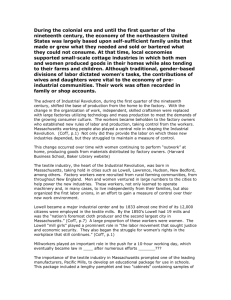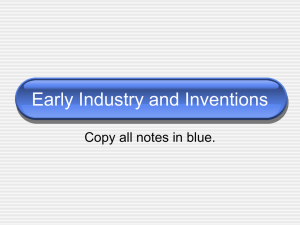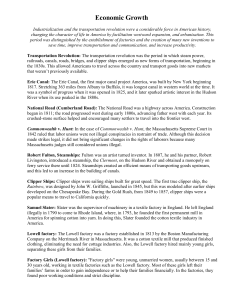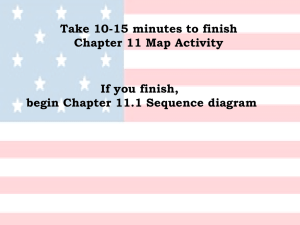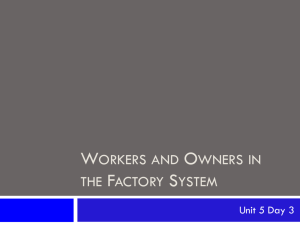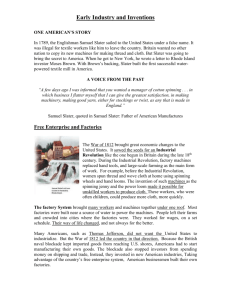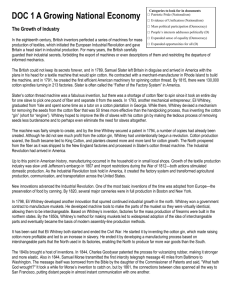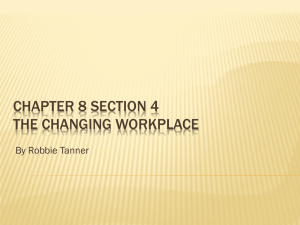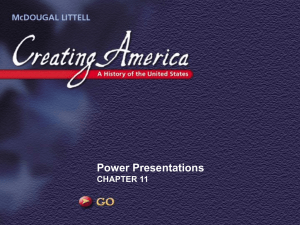Industrial Revolution PPT
advertisement
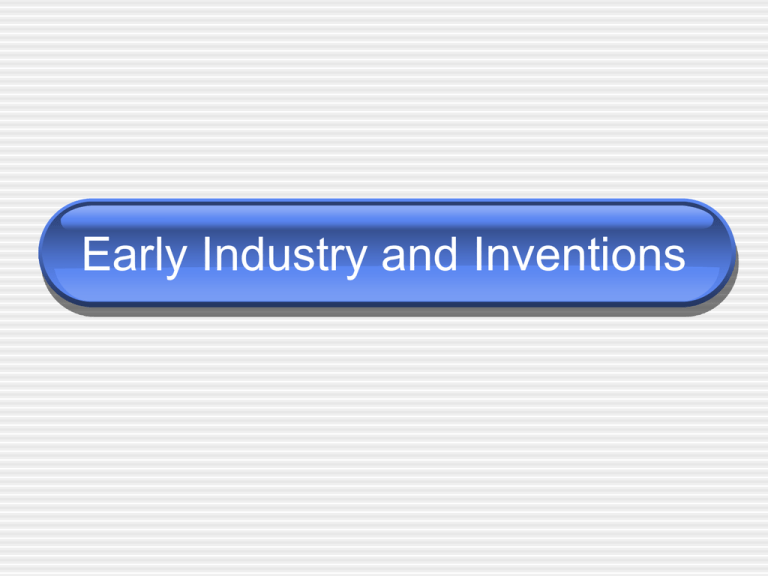
Early Industry and Inventions Inventors and Famous Inventions Industrial Revolution • British inventors began to make textiles with machines. • A British textile worker, Samuel Slater, set up a textile factory in Rhode Island in 1790. • This was the beginning of the Industrial Revolution in the U.S.! Industrial Revolution • The first Industrial Revolution began in England in the late 18th century. • An industrial revolution is when hand tools are replaced by factory machines, and farming is replaced by large-scale manufacturing. • An example is the making of clothes. Spinning Jenny and Power Loom • Before the Industrial • • Revolution, clothes were made at home. Afterwards, clothes were made by machines in factories. Often these machines were run by children. Factory System • The factory system had many workers under one roof working at machines. • Many people left farms and moved to the city to work in factories. They wanted the money that factories paid. • This change was not always for the better. Factories Come to New England • New England was a • good place to have a factory. Factories needed water power, and New England had many fast-moving rivers. The Lowell Mills Hire Women • In 1813, Francis Cabot Lowell built a • • • • factory in eastern Massachusetts, near the Concord River. The factory spun cotton into yarn and wove the cotton into cloth. Something was different about this factory, they hired women. The “Lowell girls” lived in companyowned boardinghouses. The girls worked over 12 hours a day in deafening noise. The Lowell Girls • Young women came to • • Lowell in spite of the noise. They came for the good wages: between two and four dollars a week. The girls usually only worked for a few years until they married. Less Dependency on Europe * As a result, the U.S. no longer had to buy finished textile products from Europe! View the inside of a 19th century textile mill. (Lowell, MA ) 1845 Lowell factory pamphlet Interchangeable Parts • The first use of interchangeable parts was • • • • created by inventor Eli Whitney. Before this time, guns were made one at a time. Each gun was different. If a part broke, a new part had to be created. Whitney created muskets with exactly the same parts, so any part would fit any gun. The use of interchangeable parts speeded up production, made repairs easier, and allowed the use of lower-paid, less skilled workers. Factory Workers • Women were paid half as much as men. • Working hours were long, and wages were low. Ex.) 12-15 hour work days Earnings: men - $5 per week women - $2 per week children - $1 per week • Cities developed as farmers and immigrants took available factory jobs. Canals • Man made waterways were constructed all over the Northeast to get goods to west and east. • One canal that was built between the years 1817-1825 was the Erie Canal. New York and Canals • The Erie Canal ("Clinton's Big Ditch") opened on October • • • • • 26, 1825, 363 miles long, forty feet wide, four feet deep, 18 aqueducts and 83 locks, shortened travel time form the east coast to the gateway to the west (the Great Lakes) by half and reduced shipping costs by 90%. only trade route west of the Appalachians, prompted the first great westward migration of American settlers, turned Rochester into the nation's first boom town and made New York City the busiest port in the United States. Steamboat • Robert Fulton designed • a steam engine for a steamboat that could move against the current of a river or against the wind. The steamboat created more opportunities for trade and transportation on rivers. His ship the Clermont sailed from New York City to Albany and back in 62 hours. A record at that time. The Telegraph • The telegraph was • • • invented by Samuel Morse. This machine sent long and short pulses of electricity along a wire. With the telegraph, it took only seconds to communicate with another city. The invention of the steamboat and telegraph brought the people of the nation closer to each other. John Deere and the plow • In 1836, John Deere • invented a lightweight plow with a steel cutting edge. Deere’s plow made preparing the ground for planting much less work. Cyrus McCormick and the reaper • Cyrus McCormick • invented a mechanical reaper, cut grain from the fields. This allowed farmers to plant much more seed because they could harvest it easier. The Threshing Machine • The threshing • machine separated the kernels of wheat from the husks, which was a far faster way of getting wheat than picking it by hand. The threshing machine increased the growing of wheat. The cotton gin • Inventory Eli Whitney also • • invented the cotton gin. The gin took the seeds out of the cotton, which was much faster than doing it by hand. The cotton gin also greatly expanded the need for slaves. New Technologies help nation grow • With new farm equipment, Midwestern farmers grew food to feed Northeastern factory workers. • Midwestern farmers became a market for Northeastern manufactured goods. • The growth of the textile factories increased the demand for Southern cotton. • This led to the expansion of slavery.
